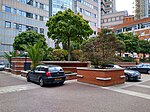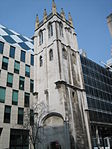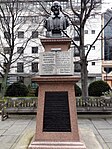125 London Wall
1992 establishments in EnglandJPMorgan Chase buildingsOffice buildings completed in 1992Postmodern architecture in the United KingdomSkyscrapers in the City of London ... and 2 more
Terry Farrell buildingsUse British English from January 2014

125 London Wall, also known as Alban Gate, is a postmodernist building on London Wall in the City of London. Along with Embankment Place and Vauxhall Cross (the SIS Building), it has been described as one of the three projects that established designer Sir Terry Farrell's reputation in the late 1980s-to-early 1990s period. In 2004, writer Deyan Sudjic described it as "postmodernism at its most exuberant", placing it at number 5 in a list of Ten Triumphs of recent UK architecture.
Excerpt from the Wikipedia article 125 London Wall (License: CC BY-SA 3.0, Authors, Images).125 London Wall
London Wall, City of London
Geographical coordinates (GPS) Address External links Nearby Places Show on map
Geographical coordinates (GPS)
| Latitude | Longitude |
|---|---|
| N 51.5175 ° | E -0.0938 ° |
Address
London Wall 125
EC2Y 5AS City of London
England, United Kingdom
Open on Google Maps









